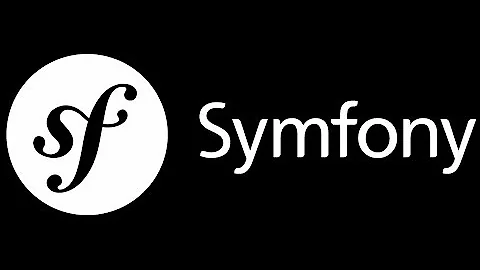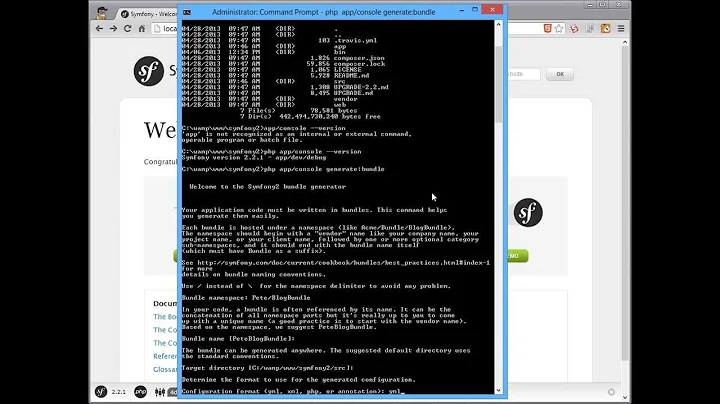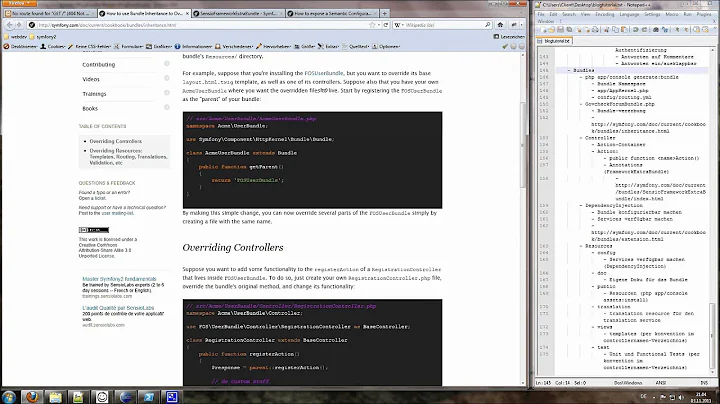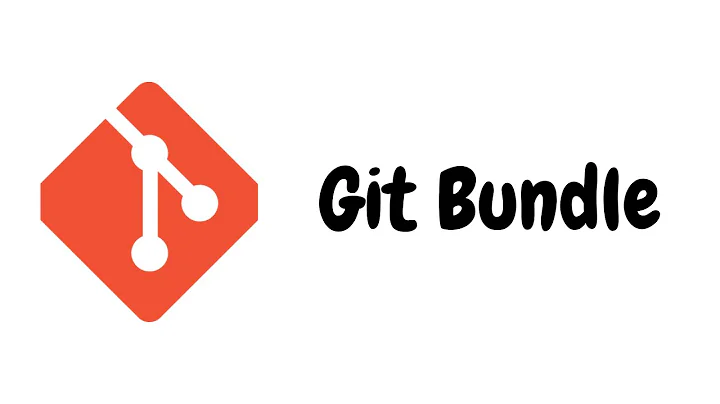Symfony2 - creating own vendor bundle - project and git strategy
Solution 1
Create a new empty symfony project
php composer.phar create-project symfony/framework-standard-edition demo/ 2.4.1
cd demo
Generate a new bundle
(for example src/Company/DemoBundle)
php app/console generate:bundle
cd src/Company/DemoBundle/
Init your github repository in src/Company/DemoBundle
git init
touch README.md
git add .
git commit -m "initial commit"
git remote add origin https://github.com/YourAccount/DemoBundle.git
git push -u origin master
Add a composer.json file
src/Company/DemoBundle/composer.json:
{
"name" : "company/demobundle",
"description" : "A demo bundle",
"type" : "symfony-bundle",
"authors" : [{
"name" : "demo",
"email" : "[email protected]"
}],
"keywords" : [
"demo bundle"
],
"license" : [
"MIT"
],
"require" : {
},
"autoload" : {
"psr-0" : {
"Company\\DemoBundle" : ""
}
},
"target-dir" : "Company/DemoBundle",
"repositories" : [{
}],
"extra" : {
"branch-alias" : {
"dev-master" : "some_version-dev"
}
}
}
Now you have the base structure of your bundle
Use it in another project
composer.json:
[...]
"require" : {
[...]
"company/demobundle" : "dev-master"
},
"repositories" : [{
"type" : "vcs",
"url" : "https://github.com/Company/DemoBundle.git"
}],
[...]
Do:
curl -sS https://getcomposer.org/installer | php
php composer.phar update company/demobundle
app/AppKernel:
new Company\DemoBundle\CompanyDemoBundle(),
Work on it
- You can clone your DemoBundle in the
src/Companyfolder, then manually install it - You can use symlink
Conclusion
You can develop and test your bundle in your first project and use it with github and composer in your second project.
Solution 2
An important point to know is that you can commit into your repo from the /vendor. Indeed, composer creates a second remote called "composer" for each bundle (or package) that references the repo of the package, in order you can work on it in a working context.
So the good practice is to register your package in your composer.json for all your projects and commit from your /vendor/MyCompany/MyBundle, from any project.
As a proof, just run git remote -v from any bundle in your vendor.
The bad practice would be to consider your bundle as a separate project and have symlinks with it. The main reason why this is the bad practice is that you won't be able to declare dependancies with your bundle. Moreover you'll have some difficulties with the deployment of your projects.
Solution 3
In Symfony4, generate:bundle command is no longer available. Instead, you may follow this tutorial.
First create a project with:
composer create-project symfony/website-skeleton my-project
Then, create a my-project/lib/AcmeFooBundle/src directory. Here will live your bundle. The namespace for this directory will be Acme\AcmeFooBundle, so if you create a service class at lib/AcmeFooBundle/src/Service/Foo.php, its namespace would be Acme\AcmeFooBundle\Service.
Now we need to tell composer autoloader to look for new classes at that new directory, so we need to edit composer.json autoload section:
"autoload": {
"psr-4": {
"Acme\\AcmeFooBundle\\": "lib/AcmeFooBundle/src/",
}
},
and run composer dump-autoload.
Now you only need to add your bundle class to config/bundles.php:
return [
...
Acme\AcmeFooBundle\AcmeFooBundle::class => ['all' => true],
];
and dependency injection to load configuration from your bundle.
If you want to check your services before adding dependency injection, you can just autowire them at config/services.yml:
services:
...
Acme\AcmeFooBundle\Services\Foo: ~
That's all. Follow best practices and go on coding.
PS: I've published a post with a few tips for developing Symfony reusable bundles.
Related videos on Youtube
Comments
-
 ex3v almost 2 years
ex3v almost 2 yearsWe're considering creating our own
commonbundle for entity mapping and services for use within few separate apps. A bundle should be easy to modify, run, include and test. I know about Best Practices for Structuring Bundles, but I don't know whatgitstrategy to use when it comes to development.Should we create
commonbundle as a whole project and commit whole repository to our git server, or is it better to start source control only for root ofcommonbundle and push only its contents? I see this approach in bundles available ongithub, but I don't know easy and comfortable way to develop bundles that way. -
Boris Guéry about 10 yearsThat's a good step-by-step, however I would suggest hosting on its own repositories as well as using Satis to service private dependencies: getcomposer.org/doc/articles/…
-
 Vincent Barrault about 10 yearssure, but maybe he has a private repository in github.
Vincent Barrault about 10 yearssure, but maybe he has a private repository in github. -
 Jovan Perovic about 10 yearsGreat answer @VBee! I did some research few days ago on the same topic but I was more interested in using private Git repos or local repos (preferred).
Jovan Perovic about 10 yearsGreat answer @VBee! I did some research few days ago on the same topic but I was more interested in using private Git repos or local repos (preferred). -
 ex3v about 10 years@VBee Great tutorial, thanks! Private repo is not a problem - we have our own git server. The problem is that I don't really get how to develop common module in team using your solution. Does every developer has to create new
ex3v about 10 years@VBee Great tutorial, thanks! Private repo is not a problem - we have our own git server. The problem is that I don't really get how to develop common module in team using your solution. Does every developer has to create newsf2project andclonethis repo intosrc/? What aboutcomposer.lockfor main project and using it to assure same version of every library across team? If you know good and effective way to do that, please, add it to your answer. Thanks! :) -
 Stéphan Champagne about 10 yearsJust a typo composer.phat should be composer.phar
Stéphan Champagne about 10 yearsJust a typo composer.phat should be composer.phar -
tftd almost 10 yearsFor anybody who's researching this topic, you could have a look at the boilerplate
LilaConceptsBestPracticeBundle(github.com/LilaConcepts/LilaConceptsBestPracticeBundle). It'll give you a great starting point. -
 Dimitry K over 9 yearsMind that parameter
Dimitry K over 9 yearsMind that parameter"target-dir" : "Company/DemoBundle"uses forward-slash/when specifying target dir, and"psr-0" :"Company\\DemoBundle" : ""}uses escaped ` \\ ` backslash. -
 Serge Velikan over 9 yearshow about making bundles like Sylius does? it has many bundles [READ-ONLY] and "replace" in composer.json, but how does this work… I don't understand yet
Serge Velikan over 9 yearshow about making bundles like Sylius does? it has many bundles [READ-ONLY] and "replace" in composer.json, but how does this work… I don't understand yet -
Sergey Kolodyazhnyy over 8 yearsNow you can use
pathrepository type, composer will create symlinks by itself getcomposer.org/doc/05-repositories.md#path -
k0pernikus over 8 yearsHow to add a vendor inside the Bundle? I want my bundle to be glue code to a custom library, hence I want to require a vendor library for it, yet am unsure where to require it. I think it should be inside the Bundle's composer.json.
-
Exit196 over 8 yearsI am creating own vendor Bundle. I want put this bundle for example on GitHub and use it in other projects. I should generate new Bundle in
/srcor in/vendordirectory at start? When i include this Bundle to other project it will be in/vendorbut where i should genate them at start? -
flouflou2000 over 8 yearsCreate a new empty project in GitHub that will store your bundle. Commit a composer.json in it. You can even commit a very simple composer.json, with only the name and the description of your bundle. Back in your project, add a requirement to your new bundle and do a
composer update. Now you should see your empty bundle in the vendor folder and you can work in it. If you want your bundle to be public, add it to Packagist. -
Sandor Farkas over 7 yearsThis should be part of the symfony documentation. Good job, thx
-
 Emiliano Sangoi about 7 yearsYou can create composer.json file with composer init command ( getcomposer.org/doc/03-cli.md#init )
Emiliano Sangoi about 7 yearsYou can create composer.json file with composer init command ( getcomposer.org/doc/03-cli.md#init ) -
ReaperSoon about 6 yearsYou cannot use symlink as git does not accept files beyond symlinks
-
 Manolo almost 4 yearsBTW, I also created a project for developing reusable bundles: github.com/msalsas/symfony-bundle-skeleton
Manolo almost 4 yearsBTW, I also created a project for developing reusable bundles: github.com/msalsas/symfony-bundle-skeleton







